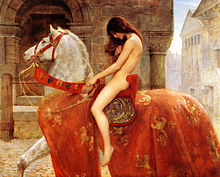Nudity (motif)
The nudity is found in the literature time and again as a symbol of internal or external conditions. The lack of clothing in individual persons, groups of people or entire peoples is then not simply an expression of a life close to nature, but reflects the intentions of the author. Various literary functions are also possible.
Depending on the context, nudity can be assigned various positive and negative meanings, such as childlike, simplicity, perfect beauty and openness (see ideal nudity or heroic nudity ), but also nakedness, poverty, humiliation or defenselessness.
religion
Biblically speaking, nudity was seen as an outward sign of man's turning away from God (cf. Adam and Eve : after they had eaten the forbidden fruit , they recognized that they were "bare", that is, stripped of God's protection. , Naked "translated and represented. Gen. 3,7). In the context of deadly sins , with the emergence of the catalogs of deadly sins, carnality and lust appear as a vice that is particularly attached to fools. While a pious person follows the so-called caritas (dt. Neighborly love ), the fool devotes himself to carnal love (lat. Amor carnalis ). Therefore, in order to illustrate the closeness to the vice of carnality, the fool often appears naked in iconography of the Middle Ages .

Legend
In the legend of Lady Godiva, which has been documented since the 13th century, a noblewoman rides naked through the city of Coventry to impress her husband with her courage.
Examples
Nudity is more common in both older and newer science fiction literature (in the broader sense). It is not difficult to see the influences of nudism and naturism in some authors , for example Isaac Asimov in his novel Lunatico , or: The Next World (1969). In Kurt Vonnegut's Slaughterhouse 5 or the Children's Crusade , however, the main character Billy Pilgrim finds himself as a naked cage animal in a zoo on the planet Trafalmadore.
In some novels and stories by Robert Heinlein , especially in the satirical novel A Man in a Strange World (1961), nudity serves as a symbol of an alternative way of life, as a protest against the traditional, as a sign of liberation from old constraints. Criticism of the Western lifestyle is largely brought up with a wink. In Marion Zimmer Bradley's extensive work Die Nebel von Avalon (1982) , nudity only plays a role in a short section, but the meaning is characteristic of the whole story. Here, nudity stands for naturalness and innocence, but also for threat and vulnerability.
The protagonist Nelly Senff in the novel Campfire by Julia Franck wants to leave the GDR for the Federal Republic of Germany . When she crosses the border, she has to undress in front of the GDR border guards. Naked in front of the border guards, she even has to undergo a vaginal examination. This is carried out by a craftsman and not by a gynecologist . Nelly's nudity can be seen here as a parable of the situation of the GDR population, who was completely defenseless in the eyes of the Stasi . The Stasi even had insights into the private sphere of the citizens.
In the novel The Testament of John Grisham , alcohol addicted lawyer Nate O'Riley is sent into the Brazilian jungle to find a wealthy heiress who works as a missionary there. He finds her with an Indian tribe whose members do not know what clothes. The missionary is the only one dressed. The carefree nudity of the Indians serves here as a symbol of the distance between the civilized , clad whites and the uncivilized, naked savages . As an American, Nate finds it completely unbelievable how uninhibited the Native American women and men live without clothes. He also finds it remarkable that the Indians have complicated rules of living together, but do not even wear clothes. For example, men and women regularly bathe several times a day, but never together.
literature
- F. Bayl: The naked person in art. Cologne 1964.
Individual evidence
- ^ Arnd Krüger : There goes this art of manliness. Journal of Sport History 18: 1, 135-159 (1991); http://library.la84.org/SportsLibrary/JSH/JSH1991/JSH1801/jsh1801i.pdf on . 19th February 2017.
- ↑ Julia Franck: Campfire, Cologne 2003, ISBN 3-423-13303-1